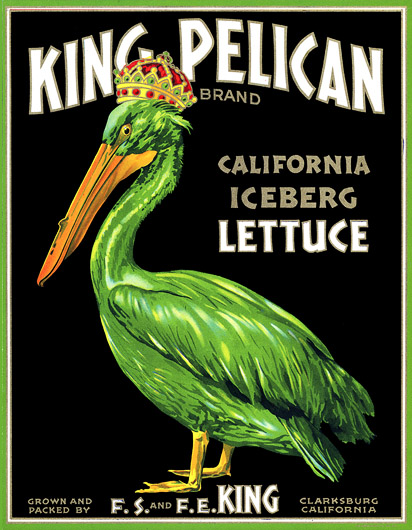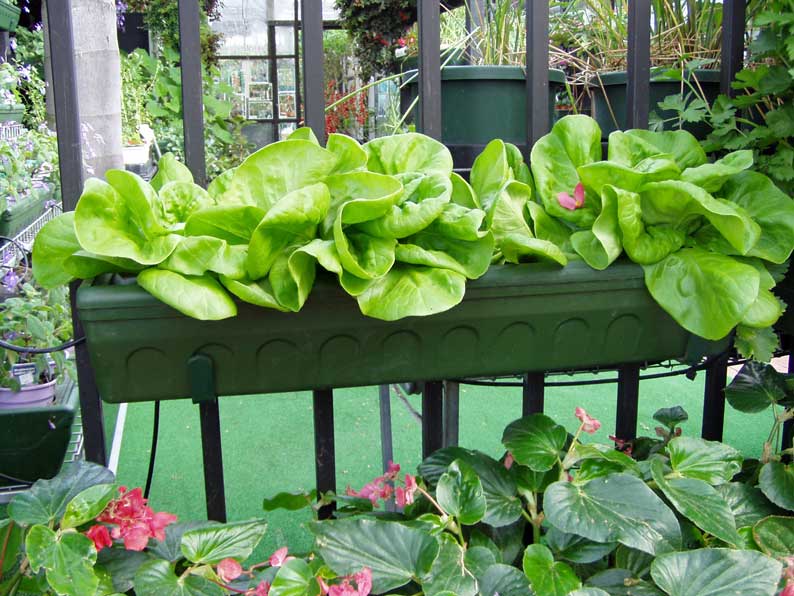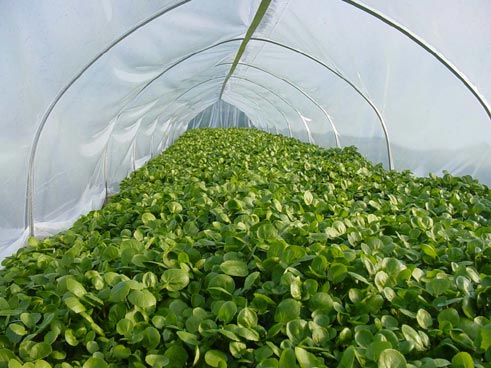The Blogging Farmer
Alex Tiller’s Blog on Agriculture and Farming
Just The Tip of the Iceberg
Iceberg lettuce is the quintessential main ingredient for salads in the USA. In some places, romaine and red-leaf lettuces make their way into people's salad bowls as well. The real connoisseurs, however, enjoy the butterhead lettuces like the Bibb, Bost, and Buttercrunch varieties. These are usually available only on a seasonal basis, unless you want to pay an arm and a leg for shriveled, tasteless leaves that were shipped 1500 miles or more.
The salad crowd doesn't adjust their taste buds according to the calendar, however, and the year-round availability of other forms of produce has created an expectation that whatever we want to eat will be on the store shelves. Unlike many forms of produce--oranges and apples, for example--lettuce doesn't "keep" or travel very well and so the usual mechanisms of retaining some product for the winter months, or importing from warmer climes, isn't very practical. One option for agricultural producers who would like to be able to market high-end lettuces in the cold months is to grow lettuce indoors, using a hydroponic or aeroponic system.
You may be interested to know that lettuces are the fourth largest hydroponic crops, coming in right behind peppers (tomatoes and cucumbers are in the top two spots). The overall hydroponic lettuce crop in the U.S. is relatively insignificant compared to what's grown conventionally in the field, but they are very much in demand, especially by restaurants and gourmands. You may recall "field-packed" lettuce that was offered in some supermarkets awhile back - full of dirt, full of bugs, requiring thorough washing before you even thought about eating it.
Butterhead lettuce: a European staple now catching on in the U.S. in a big way.This isn't an issue with hydroponic lettuce, which is usually sold in plastic bags or rigid "clamshell" containers. In some high-end stores, some lettuce products are sold as "living lettuce," with the roots still attached. In any event, hydroponic lettuce is usually ready to eat, though many people like to give it a quick rinse and spin in the salad spinner before they serve it up.
We've discussed the advantages of indoor or greenhouse hydroponic agriculture before: primarily, it can be done year-round, and as long as growers take the proper steps, insect pests and plant diseases are usually not a problem, and it's possible to grow larger plants in a shorter amount of time. Furthermore, with the use of computers and the right software, much of the day-to-day maintenance of a hydroponic system can be automated.
Some varieties of lettuce are better for indoor and greenhouse cultivation than others. Iceberg lettuce is known as a "crisphead." This means that the leaves are very tight and the heads are dense, much like cabbage. When it comes to hydroponics, the butterhead lettuces mentioned above seem to do much better. (They're called "butterheads" because the heads tend to be loose and the leaves have a texture similar to butter.) These are the gourmet greens that have long been popular in Europe and have been catching on in the U.S. in a big way.
So with all this demand, and with all the advantages of hydroponics, how come your local grocery store isn't bursting with gourmet lettuce in January? Well, here's the bad news: while lettuces are somewhat hardy (they grow best when the weather is cooler, and a few can even survive freezing), they can be rather finicky--and getting them started can be a challenge. For one thing, lettuce seeds tend to be very, very small. This means planting them by hand can be a royal pain. There are some production approaches that mitigate this difficulty for hydroponic farmers. One is to buy what is known as "pelletized" lettuce seed. The advantage here is that each seed is contained within an inert material (like clay) that's about an eighth of an inch in diameter. The surrounding material retains moisture in case a watering cycle gets skipped, and the shape allows the use of an automatic seeder. The downside is that pelletized seed is more expensive than regular seed. Either way, there is a high cost, whether in the form of special seed or in the form of lots of labor expense.
Hydroponic lettuce: Not an explosive-growth industry, but that may be changing.As mentioned earlier, most problems associated with conventional outdoor cultivation are not issues when it comes to growing hydroponic lettuce. Indoor growing does come with its own hazards, however. Moth infestations, not usually an issue in outdoor farming where the birds will do the work of pest control, can be a major hassle for hydroponic lettuce growers. And the upside of hydroponics--the farmer can control everything--can also be the downside--the farmer HAS to control everything. Many of the techniques that individual-scale hydroponics growers use to keep their crops healthy and happy just don't scale up well when the farm is twenty thousand square feet instead of a ten by ten greenhouse. But the real obstacles to this form of farming, just as much now as back when hydroponic farming was first conceived, are related to capital. It costs a lot of money to start a farm - but it costs even more to start a farm inside a building. (And if that building is located in suburban Seattle or the outskirts of New York City, rather than in Iowa, you can add a "0" to the end of the final price tag.) Labor costs tend to be higher--hydroponic technicians expect a higher wage than farmhands. And the operational expenses--special seed, nutrient solutions, etc.--can quickly erase the potential gains from lower fertilizer or pesticide prices higher yield turns.
Those higher costs have been the principal reason that hydroponic production of lettuce and other farm products has not been an explosive-growth industry, despite the many years of predictions that it would be. However, the increasing sophistication of American tastes for salads, increasing fuel costs for shipping of produce from traditionally agricultural areas, water issues, and the burgeoning desire of many city dwellers to get their food from close at hand rather than relying on an aging and expensive transportation network, may be changing that. (Posted on May 23, 2011. Read more of Alex Tiller’s blogs on agriculture and farming.)
Hello, and thanks for checking out my blog. My name is Alex Tiller and I grew up in rural Ohio (Clark County) where my family still owns farmland (corn and beans). I am a member of the American Society of Farm Managers and Rural Appraisers and am also an agribusiness author/blogger. I write about commercial farming, family farms, organic food production, sustainable agriculture, the local food movement, alternative renewable energy, hydroponics, agribusiness, farm entrepreneurship, and farm economics and farm policy. I visit lots of farms in different areas of the country (sometimes the world) that grow all kinds of different crops and share what I learn with you through this blog.? You can contact me via email by clicking here: Email Alex
Founder/Publisher/Editor: David McGee
Contributing Editors: Billy Altman, Laura Fissinger, Christopher Hill, Derk Richardson
Logo Design: John Mendelsohn (www.johnmendelsohn.com)
Website Design: Kieran McGee (www.kieranmcgee.com)
Staff Photographers: Audrey Harrod (Louisville, KY; www.flickr.com/audreyharrod), Alicia Zappier (New York)
E-mail: thebluegrassspecial@gmail.com
Mailing Address: David McGee, 201 W. 85 St.—5B, New York, NY 10024





